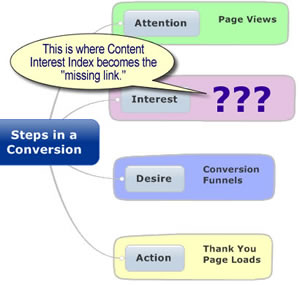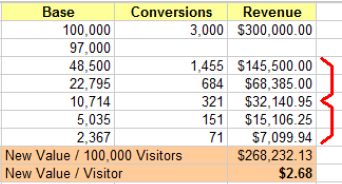Those who have been following me on Jason Fall’s blog Social Media Explorer know that I’ve begun my guest appearances there with a discussion of Content Interest Index (CII). You may also recall from my recent post, Overcoming the treachery of analytics, that I urge web marketers to be ruthless in the elimination of unnecessary metrics from their reporting. That may seem contradictory.
That’s why this post includes a little more information on exactly where the CII comes in handy and how it appears to be unique in doing some important work.
Attention
In a web visit, Attention is measured by Page Views. Each view is evidence of a page commanding user attention. It’s an opportunity to draw the prospect deeper into the sales process. By the way, a “sale” in this instance is defined as any commitment including but in no means limited to the following:

- Setting an appointment
- Requesting more information
- Filling out a request for quote (RFQ)
- Subscribing to an email newsletter
Interest
Interest is the “missing link,” in terms of what can be quantified within a web visit. Some attempts at measuring this are commonly called engagement metrics. They’re limited in when they can be used. An example of an engagement metric is counting how many people view an embedded video, or tracking how long they stay and watch. Other metrics, such as bounce rates, are better at gauging interest at a session level, not a page level. Content Interest Index (CII) is an attempt to measure interest by tracking a number of user behaviors.
Desire
Desire, defined in this instance, is activity that demonstrates strong buying interest and a high probability to convert. It is the water circling the drain, or — to use a more web-specific metaphor — descent into a conversion funnel. In both online conversions and face-to-face selling, this stage is the answering of objections and a clarification of the real costs and benefits of the commitment. Conversion funnels are fairly easy to configure to track these behaviors.
Action
Action is the fourth and final stage of a sale or conversion, and is as easy to quantify using conventional web metrics as the desire stage. It is the actual transaction. In most analytics systems, conversions are measured when a confirmation page loads, such as a “Thank you for requesting an appointment,” or “… for inquiring,” etc.
Using Content Interest Index to improve content
The primary use of CII is as a content management coaching tool. This is an extremely new metric, but promises to provide insights into raising the “interest quotient” of pages surrounding conversion funnels. In attracting more interest — especially via social media sharing — pages optimized through CII appear to be better at actually feeding visitors into important conversion funnels.
By finally allowing digital marketers to measure every link in the chain to conversion, content interest index has the potential of increasing the number of people entering conversion funnels, and thereby improving the conversion success of the entire web site.
Watch Social Media Explorer for my post early next week on how specifically CII is measured.

 The metric is called CII: Content Interest Index. I’ve been wrong more than once in my career. Sometimes I’ve been wrong in spectacular ways. But I firmly believe from what I’ve witnessed that this is a unique and valuable tool for managers of many types of sites.
The metric is called CII: Content Interest Index. I’ve been wrong more than once in my career. Sometimes I’ve been wrong in spectacular ways. But I firmly believe from what I’ve witnessed that this is a unique and valuable tool for managers of many types of sites.